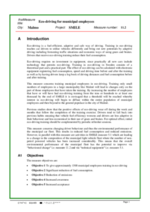Eco-driving training for municipal employees
Thematic areas
Behavioural change & mobility management
- Mobility marketing and awareness raising
- Mobility Planning
Summary
Eco-driving is a way to minimise fuel consumption by more efficient driving techniques, and driver training demonstrates how economic and environmental benefits can go hand in hand. Photo credit: Mats Persson
Implementing sustainable mobility
Prior to measure implementation, pilot studies had been carried out in a number of Swedish cities, including Malmo, to teach drivers a more efficient and safer way of driving. However, it was clear that wider numbers of drivers needed to be reached in order to achieve lasting effects and to raise awareness by creating a critical mass of trained drivers. By offering the training to a greater number of municipal employees, it was hoped to reach a threshold at which interest in eco-driving would begin to spread throughout the entire staff of the municipality, and beyond to the general population.
Eco-driving requires no investment in equipment. Instead, it
The specific objectives were therefore to:
- offer eco-driving training to 1,500 municipality employees;
- achieve a significant reduction in fuel consumption (between 10 and 15 percent);
- reduce emissions; and
- increase awareness and acceptance of eco-driving techniques.
Progress
By the end of 2008, a total of 1, 091 employees were trained. The training comprised both theoretical and practical elements and equipment was used in the six vehicles to gauge the effect of the training on fuel consumption. Two trips were made with the instructor: one according to the driver’s usual driving technique, and a second with guidance from the instructor. Fuel consumption on each trip was measured and the difference calculated.
Outcomes
Only a small proportion of municipal employees in Malmo were trained in eco-driving, leading to a reduction in fuel consumption for the total fleet of between 0.27 and 0.13 percent, and a reduction in emissions by approximately 0.47 percent, representing a very marginal improvement. However, consumption per trained employee decreased by an average of 13 percent, indicating that the measure has good potential for achieving environmental benefits.









